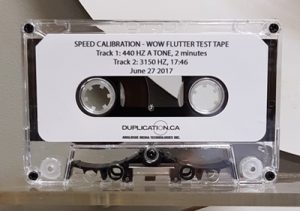Every cassette deck runs at a slightly different speed. The tolerance of a machine made in 1990 when brand new was 0.5% to 2%. After 25+ years, it is pretty sure that your 25 year old machine needs new belts and a speed calibration. An exception could be made for machines with direct drive capstan motors. Very few machines had direct-drive capstans because they were very expensive.
How to adjust the speed of cassette decks
Many cassette decks have a hole in the back of the capstan motor. This hole is usually covered by a rubber shroud, and you can insert a small jeweler’s screwdriver to connect with a potentiometer which allows adjustment of the speed. This adjustment is often very sensitive and it’s difficult to get a very precise and stable speed – a very small adjustment can result in a huge speed variance. Better decks might have an adjustment potentiometer on the PC board which allows a much more precise setting of the speed.
We offer a test tape containing a 440Hz A tone and a 3150 Hz tone to assist in setting the speed of your cassette deck.

https://www.duplication.ca/shop/audio-cassette-speed-calibration-test-tape.html

















Seems all very logical, but what if you had a Direct Drive Motor deck and want to adjust its speed? Do you easily turn a pot somewhere? Does it require a different resistor in series or do we have to change the diameter of the flywheel to accomplish this task?
To avoid having to deal with different speeds on decks that were not calibrated correctly, I purchased a Sony Cassette deck TC-WE475 that has a pitch control knob right on the front panel.I use it frequently when coming across audio that is not available elsewhere but is still on cassette from many years ago. Once the speed and pitch is corrected,then I transfer the audio to my computer and save it as an mp3. The deck is a dual cassette version but I never use the “B” side since it’s really only for copying cassette to cassette. The pitch control only works on the “A” deck side.
Thank you for posting this very helpful tip! Can I assume turning left (counter clockwise) slows the motor and vis versa?
Thank you very much! I thought mine was broken but with your help, I was able to fix it!